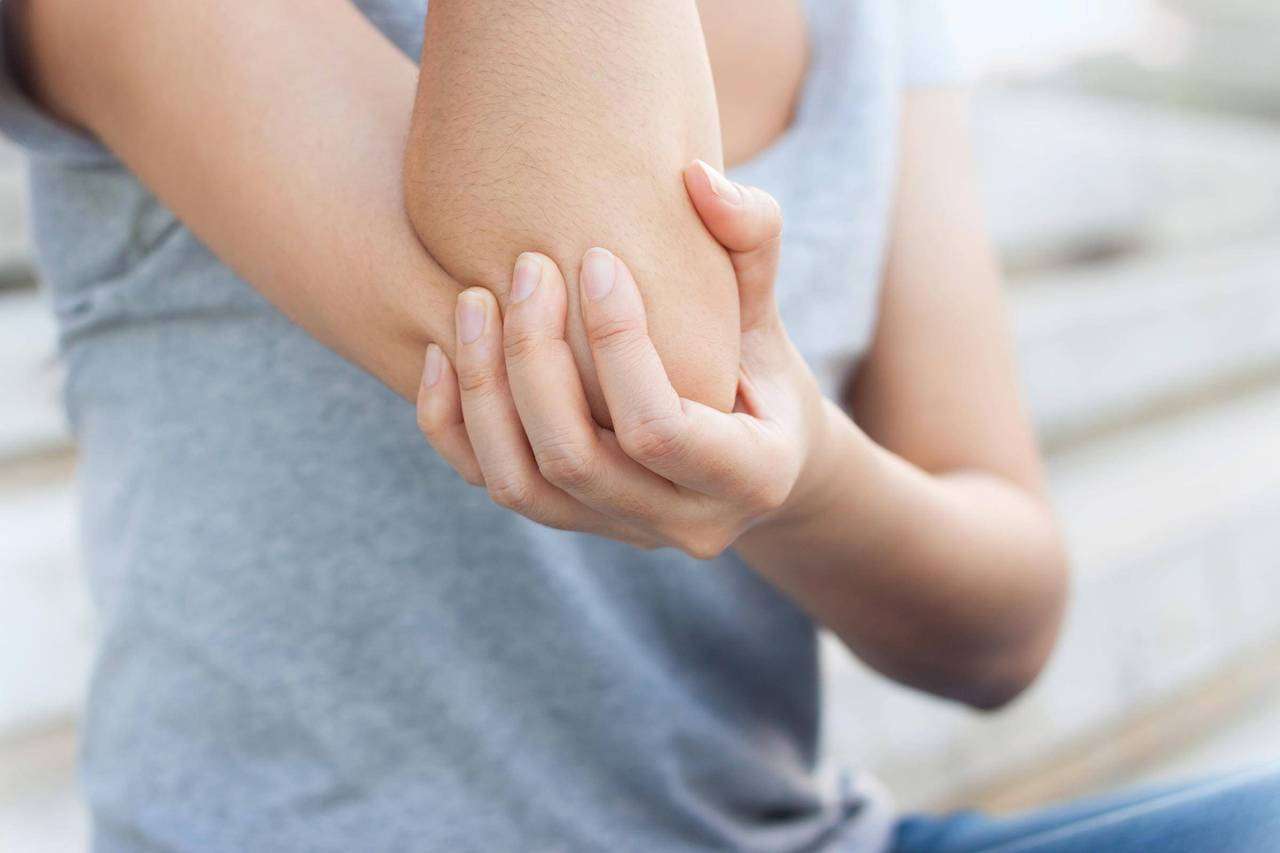Introduction
What Causes Tricep Tendonitis: One of the most common causes of tricep tendonitis is overuse or repetitive strain on the triceps muscle and tendon. This can occur in athletes or individuals who engage in activities that involve repetitive arm movements, such as weightlifting, throwing sports, or even excessive typing and computer use. Muscle imbalances in the shoulder and arm can place added stress on the triceps tendon.
Weakness in other muscles surrounding the elbow and shoulder joint can lead to compensatory movements and increased strain on the triceps tendon. Incorrect exercise or lifting techniques can strain the triceps and their associated tendons. Using improper form, lifting weights that are too heavy, or sudden increases in training intensity can all contribute to tendonitis.
As people age, tendons tend to naturally degenerate and become less flexible. This can make them more susceptible to injury and inflammation. A direct blow or injury to the triceps muscle or the tendon itself can cause inflammation and lead to tendonitis. Certain medical conditions, such as rheumatoid arthritis or systemic diseases, can increase the risk of developing tendonitis.

How do you get rid of tricep tendonitis?
Treatment Options for Triceps Tendonitis
A cold compress may be applied to the affected elbow several times a day for about 15 to 20 minutes at a time. Light compression using a bandage and elevating the elbow above the level of the heart will also help to reduce swelling and pain.
Tricep tendonitis, a condition characterized by inflammation and irritation of the triceps tendon, can be a painful and limiting ailment.
Rest and Avoid Overuse
One of the first and most steps in treating tricep tendonitis is to give your affected arm adequate rest. Overuse or continuing activities that aggravate the condition can worsen the inflammation and prolong recovery. It’s essential to identify and avoid activities that strain the triceps tendon during the healing process.
Ice and Anti-Inflammatory Medications
To alleviate pain and reduce inflammation, apply ice to the affected area for 15-20 minutes several times a day. Non-steroidal anti-inflammatory drugs (NSAIDs), such as ibuprofen or naproxen, may also help to manage pain and swelling. Consult your healthcare before using any medication.
Physical Therapy
Physical therapy is often a crucial component of tricep tendonitis recovery. A trained physical therapist can design a personalized exercise program that focuses on strengthening the triceps and the surrounding muscles. This program can help to improve flexibility, alleviate pain, and restore the full range of motion in your arm.
How long does it take to heal tricep tendonitis?
Average recovery times for biceps tendonitis or triceps tendonitis depend on the severity of the injury and the level of care shown. For mild irritation, many patients may see full recovery in several days. In some cases, it can take weeks to months to show noticeable improvement.
Severity of Tendonitis
The severity of tricep tendonitis plays a significant role in determining the healing time. Mild cases of tendonitis, characterized by minor inflammation and discomfort, may resolve more quickly, often within a few weeks, with appropriate rest and self-care measures.
Treatment Approach
The chosen treatment approach can influence the healing timeline. Conservative treatments, such as rest, ice, physical therapy, and anti-inflammatory medications, are typically the first-line options. When diligently followed, these treatments can lead to a faster recovery. Physical therapy, in particular, can help strengthen the triceps and surrounding muscles, improving the healing process.
Rest and Activity Modification
Resting the affected arm and avoiding activities that strain the triceps tendon are critical components of recovery. Depending on the severity, this period of rest may last for a few weeks to a couple of months. Overuse or premature return to strenuous activities can delay healing.
How common is tricep tendonitis?
Triceps tendonitis is not very common, but when it does occur, it’s typically caused by overusing your triceps muscle. Your triceps muscle runs along the back of your upper arm and is attached to the point of your elbow by a tendon.
Tricep Tendonitis Prevalence
Sports and Physical Activity: Tricep tendonitis is frequently seen in individuals who engage in repetitive arm movements or overuse their triceps. Athletes involved in sports like weightlifting, baseball, tennis, and golf, which require frequent use of the triceps, may be more prone to this condition.
Age: As individuals age, the tendons in their bodies naturally become less flexible and more susceptible to injury. Tricep tendonitis can affect people of all ages, but it may be more common in older adults due to age-related degeneration.
Occupation: Certain occupations that involve repetitive arm motions or heavy lifting, such as manual labor or office work with excessive mouse usage, can increase the risk of developing tricep tendonitis.
Muscle Imbalances: Muscle imbalances in the shoulder and arm can also contribute to the development of tricep tendonitis. Weakness in other muscles surrounding the elbow and shoulder joint can lead to compensatory movements and increased strain on the triceps tendon.
Lifestyle and Exercise Habits: Lifestyle choices, including lack of warm-up and stretching before exercise, can predispose individuals to tricep tendonitis. Poor exercise techniques and lifting heavy weights without proper form can also be contributing factors.
Can I still workout with tricep tendonitis?
The best triceps tendonitis treatment is to give your tendon a break without totally resting it (relative rest) and then to strengthen it with exercises that don’t make your injury worse.
Tricep tendonitis, characterized by inflammation and irritation of the triceps tendon, can be a painful and limiting condition.
Consult a Healthcare Professional
Before making any decisions about working out with tricep tendonitis, it’s crucial to consult with a healthcare professional. They can a proper diagnosis, assess the severity of your condition, and offer personalized treatment and exercise modifications.
Rest and Recovery
In many cases, the initial treatment for tricep tendonitis involves rest. You may need to temporarily avoid activities that exacerbate the pain, including exercises that directly target the triceps. This rest period allows the inflamed tendon to heal and reduces the risk of further injury.
Proper Warm-Up and Stretching
Before any workout, dedicate time to a thorough warm-up routine. Gentle cardio, such as light jogging or cycling, followed by dynamic stretching, can help prepare your muscles and reduce the risk of aggravating your tricep tendonitis.
Is tricep tendonitis permanent?
Often, triceps tendonitis can get better with simple rest. At times, medicine may be needed to help the pain get better.
Tricep Tendonitis and its Stages
Acute Stage: In the early stages of tricep tendonitis, when symptoms first appear, the condition is generally considered acute. Acute tendonitis can be painful and limiting but is often treatable with rest and conservative measures.
Chronic Stage: If left untreated or if conservative treatments are ineffective, tricep tendonitis can progress to a chronic stage. Chronic tendonitis may involve long-term inflammation and structural changes in the tendon. In some cases, chronic tendonitis can lead to tendon degeneration.
Treatment and Outlook
Acute Tricep Tendonitis: In the acute stage, tricep tendonitis is often treatable and may not be permanent. With appropriate rest, ice, anti-inflammatory medications, physical therapy, and lifestyle modifications, individuals can experience significant relief and a full recovery.
Chronic Tricep Tendonitis: Chronic tendonitis may require more comprehensive and long-term treatment. While complete resolution is still possible with appropriate care, it may take more time and effort to manage and heal the condition fully.
Lifestyle and Compliance
Lifestyle Modifications: Positive lifestyle changes, such as maintaining a balanced diet, staying hydrated, and practicing good ergonomics, can support the healing process.
Avoiding Overuse: Continuously overusing the triceps without proper rest or modifications to exercise routines can lead to a more persistent condition.
Is heat good for tricep tendonitis?
Heat may be more helpful for chronic tendon pain, often called tendinopathy or tendinosis. Heat can increase blood flow, which may help promote healing of the tendon. Heat also relaxes muscles, which can relieve pain.
How Heat Therapy Works
Heat therapy, also known as thermotherapy, involves the application of heat to the affected area. The heat promotes blood flow, relaxes muscles, and can alleviate pain and stiffness. It is often used for various musculoskeletal conditions, including tendonitis.
Benefits of Heat for Tricep Tendonitis
Pain Relief: Applying heat can help relieve pain associated with tricep tendonitis. The warmth can soothe sore muscles and reduce discomfort.
Improved Blood Flow: Heat increases blood circulation to the affected area, which can aid in the delivery of essential nutrients and oxygen to the damaged tissues, potentially speeding up the healing process.
Muscle Relaxation: Heat can relax tense muscles and reduce muscle spasms, which can be common in cases of tricep tendonitis.
Enhanced Range of Motion: By relaxing the muscles and promoting blood flow, heat therapy can help improve the range of motion in the affected arm, making it easier to perform stretching exercises or physical therapy.
What exercises are bad for tricep tendonitis?
Examples include throwing a baseball, hammering, bench presses, and gymnastics. These activities can cause more strain if you quickly increase how hard or how often you do them. Having tight arm muscles or some arm muscles that are a lot stronger than others can also increase stress on the triceps tendon.
Tricep tendonitis, characterized by inflammation and irritation of the triceps tendon, can be a painful and limiting condition.
Heavy Bench Press
Bench pressing with heavy weights can strain the triceps tendon, especially if proper form is not maintained. Consider reducing the weight and focusing on form during bench press exercises.
Exercises That Aggravate Symptoms
Ultimately, any exercise that causes pain, discomfort, or increased inflammation should be avoided. Individuals with tricep tendonitis should pay close attention to their body’s signals and adjust their exercise routines accordingly.
Failure to Warm Up and Stretch
Failing to warm up adequately before exercise and neglecting post-workout stretching routines can increase the risk of tricep tendonitis. Adequate warm-up and cool-down routines help prepare the muscles and tendons for exercise and promote better blood circulation.
How bad is tricep tendonitis?
Weightlifter’s elbow, also known in medical terms as triceps tendonitis, can cause significant discomfort and make many everyday activities challenging.
The good news is that tricep tendonitis is manageable, and most individuals can find relief and recovery through conservative treatments. These may include:
Rest: Adequate rest is often the first step in managing tricep tendonitis. Avoiding activities that exacerbate the condition allows the tendon to heal.
Physical Therapy: Physical therapy can help strengthen the triceps and surrounding muscles, improve flexibility, and promote healing.
Medications: Non-steroidal anti-inflammatory drugs (NSAIDs) can help manage pain and reduce inflammation.
Heat and Ice: Heat therapy can soothe sore muscles and improve blood flow, while ice can reduce inflammation and pain when applied in moderation.
Lifestyle Modifications: Lifestyle changes, including maintaining a balanced diet, staying hydrated, and practicing proper ergonomics, can support recovery.
Medical Interventions: In severe cases or when conservative treatments fail, medical interventions such as corticosteroid injections or surgery may be considered.

Conclusion
While we’ve explored several factors contributing to its development, it’s essential to emphasize the proactive measures in preventing and managing this condition. Treatment options often include rest, physical therapy, anti-inflammatory medications, and, in severe cases, medical procedures like corticosteroid injections or surgery.
Individuals should pay attention to their exercise techniques and form, ensuring they use appropriate weights and resist the urge to overexert themselves. Incorporating balanced strength-training routines that target both the triceps and surrounding muscles can help avoid imbalances that might lead to tricep tendonitis.
Warming up adequately before exercise and engaging in post-workout stretching routines can enhance muscle and tendon flexibility, reducing the risk of injury. Regular physical activity and a healthy lifestyle can also contribute to overall musculoskeletal health. For those already experiencing tricep tendonitis, seeking prompt medical attention is crucial.

